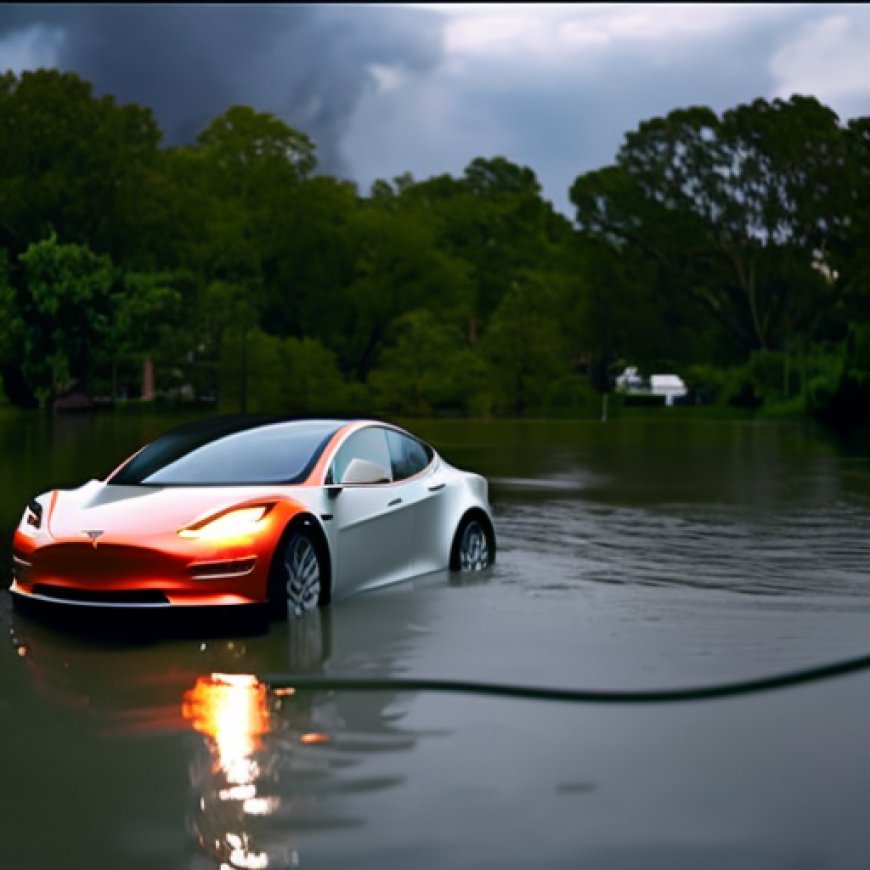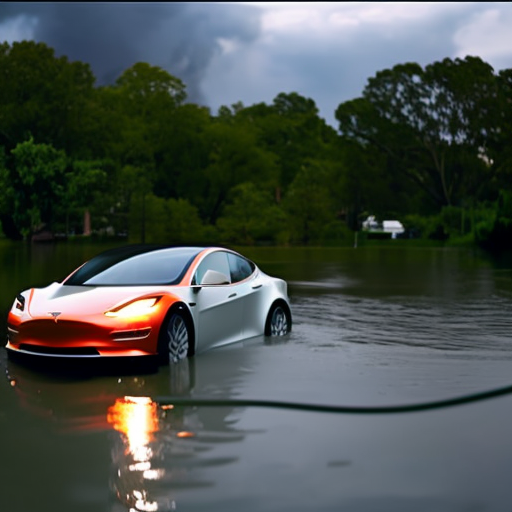Hurricane Idalia floodwaters cause Tesla to combust: What to know about flooded EV fires
Tesla on fire after Idalia flooding prompts EV combustion warning USA TODAY


Florida braced for EV fires in Hurricane Idalia flooding
A Tesla combusted Wednesday in Hurricane Idalia floodwaters near Tampa, prompting officials to remind residents of the dangers of electric vehicles coming in contact with saltwater.
Dunedin Fire Rescue, located in Pinellas County west of Tampa, confirmed crews responded to a fire Wednesday afternoon, hours after Hurricane Idalia blew by in the Gulf of Mexico.
“If you own a hybrid or electric vehicle that has come into contact with saltwater due to recent flooding within the last 24 hours, it is crucial to relocate the vehicle from your garage without delay,” the a post by nearby Palm Harbor Fire Rescue reads. “Saltwater exposure can trigger combustion in lithium-ion batteries. If possible, transfer your vehicle to higher ground.”
Even in extreme circumstances, electric vehicle fires are relatively rare
An estimated 358,000 vehicles were damaged from Hurricane Ian’s widespread flooding in Florida and the Carolinas and only 21 electric vehicles are known to have burned — a number much lower than some officials initially warned of. But the fires can be dangerous, so officials are preparing in the aftermath of Idalia.
Florida Gov. Ron DeSantis warned about EV fires as Hurricane Idalia drew closer
As reported by 10 Tampa Bay, Florida Gov. Ron DeSantis warned about EV fires as Hurricane Idalia drew closer.
“These electric vehicles when they get saltwater intrusion can catch on fire and those are very difficult fires to put out,” DeSantis said during a storm update.
21 electric vehicle fires after 2022 Hurricane Ian
According to Patronis, who also serves as the Florida State Fire Marshal, there were 21 fires related to EVs in the aftermath of Hurricane Ian, which struck Southwest Florida in September 2022. The catastrophic storm caused $115.2 billion in damages, killed 156 people and knocked out power for 2.6 million residents.
EVs less likely to catch fire than gas cars
Statistics compiled by AutoInsuranceEZ found that for every 100,000 EVs, there are about 25 fires each year. That compares to 1,530 car fires in the same number of gas-powered vehicles annually. Gas-powered cars typically catch fire due to fuel leaks or crashes.
Why do flooded EVs catch fire?
If an electric vehicle’s battery is damaged by a collision or water intrusion from a flood, a short circuit can occur, which causes the cell to discharge energy and heat up. This can lead to an event called “thermal runaway,” in which the heat propagates from one cell to the next, causing them to burn.
In a small number of cases when an EV is submerged in water, contaminants or salt in the water can cause short-circuiting, especially after the water drains from the battery.
Vehicles or batteries that have been damaged also have the potential for short-circuiting to occur due to movement of the vehicle or battery, for example when it’s being loaded or unloaded from a tow truck.
Heat generated from a fire, thermal runaway of an adjacent cell, or shorting of the battery can melt the porous membrane between the battery’s cathode and anode, causing this cell to go into thermal runaway. The heat causes the cell to vent flammable gas, which can ignite and catch fire.
“That heat can get transferred to the next cell and it can become a chain reaction,” said said Thomas Barth, chief of the special investigations branch of highway safety at the National Transportation Safety Board.
“If you have a damaged lithium-ion battery and it has energy which remains in the battery pack, we call that stranded energy,” he said. “If you initiate a thermal runaway or venting of the flammable gas, the battery can ignite.”
Experts warn that it is not necessarily likely for a EV to catch fire just because it has flooded. Only a small percentage of registered EVs caught fire, according to USA TODAY analyses.
SDGs, Targets, and Indicators
1. Which SDGs are addressed or connected to the issues highlighted in the article?
- SDG 7: Affordable and Clean Energy
- SDG 9: Industry, Innovation, and Infrastructure
- SDG 11: Sustainable Cities and Communities
- SDG 13: Climate Action
2. What specific targets under those SDGs can be identified based on the article’s content?
- SDG 7.3: By 2030, double the global rate of improvement in energy efficiency.
- SDG 9.4: By 2030, upgrade infrastructure and retrofit industries to make them sustainable, with increased resource-use efficiency and greater adoption of clean and environmentally sound technologies and industrial processes.
- SDG 11.5: By 2030, significantly reduce the number of deaths and the number of people affected and substantially decrease the direct economic losses relative to global gross domestic product caused by disasters, including water-related disasters, with a focus on protecting the poor and people in vulnerable situations.
- SDG 13.1: Strengthen resilience and adaptive capacity to climate-related hazards and natural disasters in all countries.
3. Are there any indicators mentioned or implied in the article that can be used to measure progress towards the identified targets?
- Indicator for SDG 7.3: Energy intensity measured in terms of primary energy and GDP.
- Indicator for SDG 9.4: Proportion of industries upgraded to sustainable practices.
- Indicator for SDG 11.5: Number of deaths, missing persons, and directly affected people attributed to disasters per 100,000 population.
- Indicator for SDG 13.1: Number of countries that have implemented national and local disaster risk reduction strategies in line with the Sendai Framework for Disaster Risk Reduction 2015-2030.
Table: SDGs, Targets, and Indicators
| SDGs | Targets | Indicators |
|---|---|---|
| SDG 7: Affordable and Clean Energy | 7.3: By 2030, double the global rate of improvement in energy efficiency. | Energy intensity measured in terms of primary energy and GDP. |
| SDG 9: Industry, Innovation, and Infrastructure | 9.4: By 2030, upgrade infrastructure and retrofit industries to make them sustainable, with increased resource-use efficiency and greater adoption of clean and environmentally sound technologies and industrial processes. | Proportion of industries upgraded to sustainable practices. |
| SDG 11: Sustainable Cities and Communities | 11.5: By 2030, significantly reduce the number of deaths and the number of people affected and substantially decrease the direct economic losses relative to global gross domestic product caused by disasters, including water-related disasters, with a focus on protecting the poor and people in vulnerable situations. | Number of deaths, missing persons, and directly affected people attributed to disasters per 100,000 population. |
| SDG 13: Climate Action | 13.1: Strengthen resilience and adaptive capacity to climate-related hazards and natural disasters in all countries. | Number of countries that have implemented national and local disaster risk reduction strategies in line with the Sendai Framework for Disaster Risk Reduction 2015-2030. |
Behold! This splendid article springs forth from the wellspring of knowledge, shaped by a wondrous proprietary AI technology that delved into a vast ocean of data, illuminating the path towards the Sustainable Development Goals. Remember that all rights are reserved by SDG Investors LLC, empowering us to champion progress together.
Source: usatoday.com

Join us, as fellow seekers of change, on a transformative journey at https://sdgtalks.ai/welcome, where you can become a member and actively contribute to shaping a brighter future.







